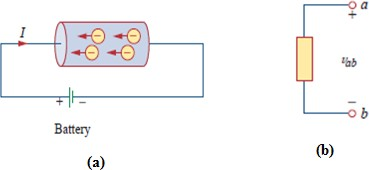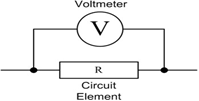Voltage
To move the electron in a conductor in a particular direction requires some work or energy transfer. This work is performed by an external electromotive force (emf), typically represented by the battery shown below. This emf is also known as voltage. The voltage ab between two points a and b in an electric circuit is the energy (or work) needed to move a unit charge from a to b.

(a) Electric Current in a conductor, (b)Polarity of voltage ab
Voltage is the energy required to move charge from one point to the other, measured in volts (V). Voltage is denoted by the letter v or V.
Mathematically,

where w is energy in joules (J) and q is charge in coulombs (C). The voltage ab or simply V is measured in volts (V).
1 volt = 1 joule/coulomb = 1 newton-meter/coulomb
Picture below shows the voltage across an element (represented by a rectangular block) connected to points a and b. The plus (+) and minus (-) signs are used to define reference direction or voltage polarity.
The ab can be interpreted in two ways: (1) point a is at a potential of ab volts higher than point b, or (2) the potential at point a with respect to point b is ab . It follows logically that in general
![]()
Voltage is always measured across a circuit element as shown below

Voltage across Resistor (R)

